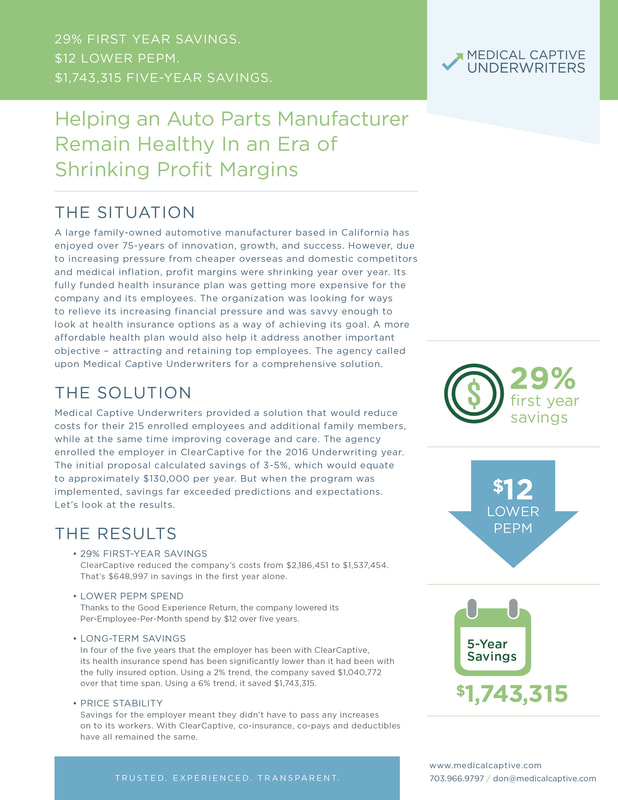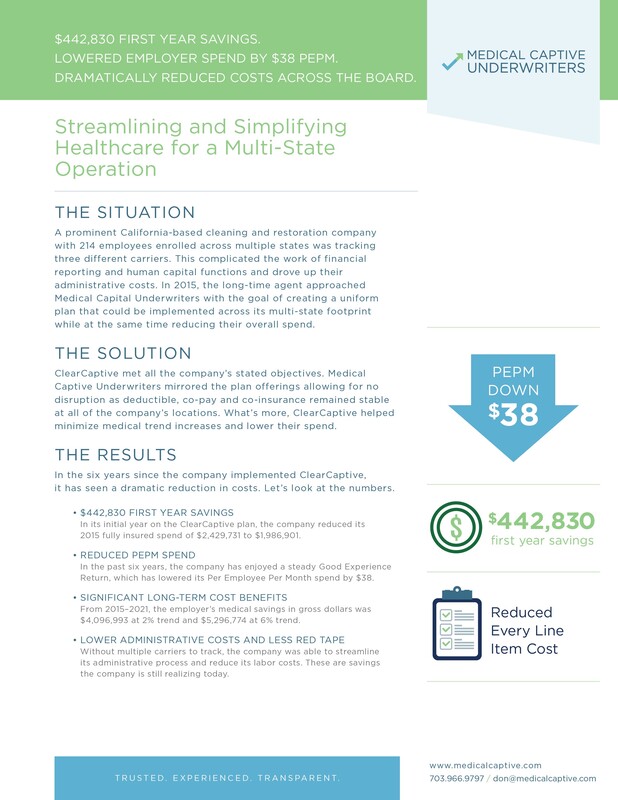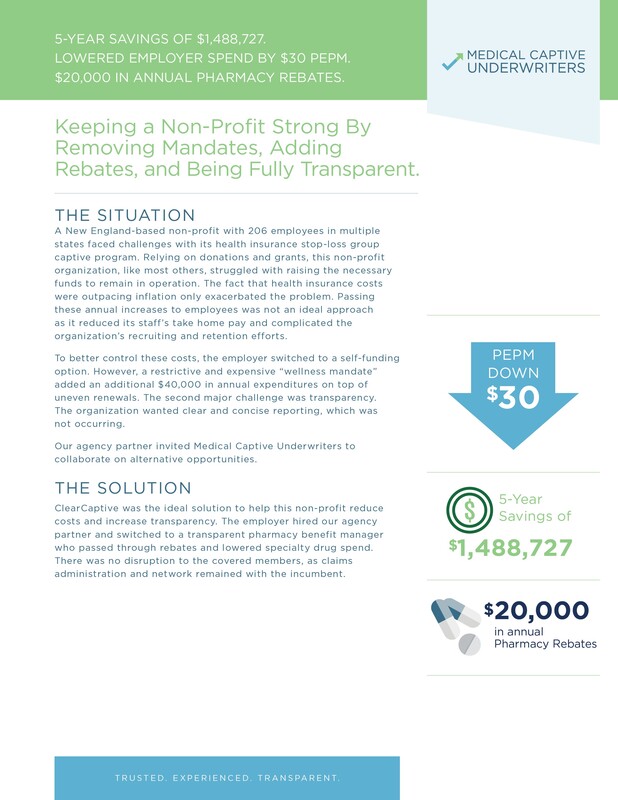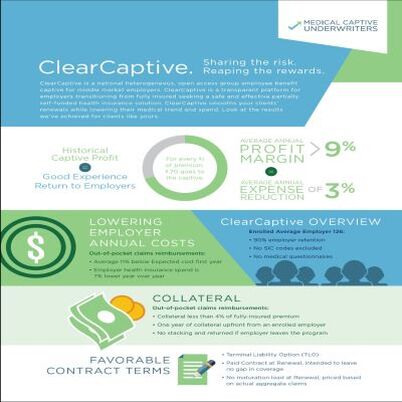|
A hallmark of self-funding benefits is the “pay as you go” approach for funding claims within the self-insured retention (SIR). The SIR is the employer deductible above the covered member deductible and the liability for claims below the stop-loss Individual Specific Limit (ISL). The SIR is the employer’s pay as you go portion, for actual member medical incurred claims.
The bulk of a self-funded employers cost is retained in the SIR. Hence, the employers best opportunity for savings rests within the SIR. The SIR is the place employers can turn pennies into nickels and dimes into quarters. In contrast, the fully insured health insurance market sets its premium and requires its customers to pay their all their premium upfront, regardless of actual claims cost or volume. The carrier exerts absolute control over employer fixed cost premiums and plans offered. Blue United Cigna Aetna and Humana/Harvard Pilgrim (BUCAH) retain underwriting profit from fixed cost premiums. BUCAH profit margins are in black and white for everyone to see, the 15% Medical Loss Ratio (MLR). The MLR expressed in dollars, increases with each extra dollar charged and paid by the employer plan sponsor or contributed by its covered members. Raising or lowering the employee deductible from $1,000 to $2,000 impacts pricing for fully insured employers more significantly than self-funded employers. A 50-500 life employer may see a 2-5% price change based upon the above employee/member deductible adjustment. The self-funded employer utilizing a $50,000 ISL making this deductible change, experiences little to no impact on its SIR or fixed cost in the self-funded pay as you go model. The employers who understand and manage the available aspects of the self-funded model are rewarded financially. A self-insured plan can work with providers to develop a comprehensive mitigation strategy tailored to their population and industry. Direct Provider Contracting (DPC), Integrated Musculoskeletal Care (IMC), Regenexx or another cutting edge mitigation or management approach. Exerting control over cost and frequency of medical procedure can impact outcomes. Employer paying attention to mitigation efforts can influence presenteeism, recruiting and retention efforts, lower turnover and improve the overall health of the population. The strength of self-funding is controlling health care costs in an employer sponsored health plan. COVID-19 remains uncertain in spite of the increasing population receiving the vaccine. Self-funding allows employers to exert tailored control as the re-opening ramps up and we collectively learn more. Don McCully runs Medical Captive Underwriters LLC, (Received first vaccine March 20, 2021 – Moderna) www.medicalcaptive.com – which sponsors ClearCaptive. ClearCaptive is a 50 state open access, stop-loss captive solution for middle market employers with at least 50 enrolled employees. We are a program management company using alternative risk transfer solutions lowering employer’s costs in both A&H and P&C insurance. Primary focus today is employee benefit advisors to lower medical spend and medical trend for employers enrolled in ClearCaptive. Plan Sponsors considering or reviewing a Stop-loss Group Captive program versus level funding or fully insured options, does cash matter?
Middle-market employer plan sponsors choose a group stop-loss captive over fully funded options for a variety of reasons. Increased data transparency derived from self-funding delivers more accurate measurements of medical spend reporting to apprise management of this unremittingly increasing expense item. Increased medical expense reduces cash liquidity on a self-funded plan sponsor’s balance sheet, especially when revenue does not grow enough to offset the rate (5.8%) of annual medical inflation over the past decade. Medical inflation grew at twice the yearly US inflation rate during this time period and is driven largely by the costs of specialty pharmaceuticals which are growing at an unprecedented rate. Also contributing are increased instances of catastrophic claims over $1 million, which have grown more than 30% annually in each of the last eight years. The growth rates in these two categories are exacerbated by the addition of fully insured carriers adding overhead and other ambiguous expense fees to their premiums. Fully insured carriers make nearly ten times the profit compared to independent, unbundled stop-loss carriers. Self-funding through a group stop-loss captive effectively lowers an employer’s costs as insurance carrier overhead, administrative fees, state premium taxes and ACA assessments are not a component of the plan sponsors directly paid RX and medical spend. Self-funding delivers a lower overall cost structure which contributes to increased cash liquidity on the employer’s balance sheet. Employer control over the plan is also accentuated as plan assets are controlled by the self-insured employer plan sponsor. Greater control to increase transparency and reduce costs are primary reasons that self-funding through a group stop loss captive is a preferred option for middle-market employers to more effectively manage this important income statement expense. A tradeoff however, for enrolling in a group captive program is the requirement to post collateral, typically in the form of cash or a letter of credit, to secure their portion of “insurance company” obligations assumed by the captive. In return, employers can expect reduced benefit costs and the opportunity receive dividend distributions from their participation in the shared profitability of the captive. Profitability dividends delivered by the captive serve to effectively lower overall employer medical spend. An example of a successful underwriting year is an employer receiving a 5% of premium return in the form of a dividend distribution from the captive. In this example, the employer posts approximately 10% of stop-loss premium in the form of collateral. The employer received a one year, 50% return on capital (cash returned divided by collateral amount). It is important to note that receiving profitability distributions from the captive/shared risk layer are not guaranteed and posted collateral is also at risk of a partial or even full loss. Cash does matter! The amount of collateral required, the number of underwriting years that collateral funds will be held, along with the percentage and frequency of dividends returned by the captive all need to be appropriately understood by the employer. Does the group stop-loss captive have a consistent history of returning profitability distributions? What is the captive program’s frequency of providing dividend distributions? Every three years, every other year or four out of five years? The experience of the underwriter combined with employer participation in initiatives that influence reductions to medical and pharmacy costs will contribute to the increased potential for delivering underwriting profit. No two programs are the same. Each employer is unique, just like each group stop-loss captive program is unique. Lowering the ultimate cost of delivering healthcare benefits to employees is a primary objective for participating in a group stop loss captive. The program should empower an employer with increased ability to control this expense line item on their income statement and improve balance sheet liquidity. Success can be measured by reducing insurance expenses, retaining more cash and receiving profitability distributions associated with an appropriate sharing and spreading of risk. Don McCully runs Medical Captive Underwriters LLC, www.medicalcaptive.com – which sponsors ClearCaptive. ClearCaptive is a 50 state open access, stop-loss captive solution for middle market employers with at least 50 enrolled employees. We are a program management company using alternative risk transfer solutions lowering employer’s costs in both A&H and P&C insurance. Primary focus today is employee benefit advisors to lower medical spend and medical trend for employers enrolled in ClearCaptive. Approximately 157 million people in the US take advantage of employer-sponsored health insurance. Companies understand that offering this benefit is crucial in their efforts to attract and retain employees. While this perk is highly valuable to workers, the rising cost of insurance is becoming problematic.
Over the past 20 years, employee contributions for health insurance coverage has grown faster than gross annual pay. These increases in deductibles, co-pays and co-insurance have all had a negative impact on employees paychecks. Fully-insured carriers are exacerbating the problem. These companies have gamed the insurance ecosystem so that they are guaranteed a 15% profit every year. With additional pharmacy rebates and other arrangements, their profits continue to grow at the expense of the employers and employees they serve. Employers, of course, are not blind to this reality and understand they need to offer a more stable plan. Towards this goal, more and more companies are looking to switch from their full-insured carriers to a self-funded option. Self-funding is a way for employers to take ownership of their plan design and pharmacy rebates. While fully-insured carriers can change deductibles, co-pay and co-insurance at their discretion, self-funded plans allow the employers to determine the amount of their employees deductibles, co-pay and co-insurance. Employers gain control. Today, 23% of small employers (those with up to 199 employees) use self-funding, and that percentage continues to grow. While premiums for small and large employers are not dissimilar, smaller employers tend to pay more of the premiums in an effort to increase participation among their staff. Group captives, a form of self-funding, is another good option. Group captives allow for the pooling of large claims to leverage the law of large number for small employers. Self-funding principles are based on paying known claims and buying insurance for unpredictable, larger claims. Wellness programs, such as health risk assessments and biometric screenings, are also becoming more popular with employers. While these programs have no real impact on insurance costs, they go a long way in building strong employer-employee relationships and have value in attracting and retaining staff members. In conclusion, fully-insured carriers offer a variety of benefits to employers and their employees, but their cost structurers are becoming untenable for both. As a result, self-funded options are becoming more attractive for those employers who are trying to control costs and help their employees keep a little more in their paychecks each week. Don McCully runs Medical Captive Underwriters LLC, (www.medicalcaptive.com). Focus is lowering medical trend and spend for enrolled employers. ClearCaptive is a 50-state open access medical stop-loss group captive solution for middle market employers with 50 employees enrolled or greater
Medical inflation continues to outpace employers’ annual revenue growth. As a result, both company profits and employee take-home pay are taking a hit. For middle market companies exploring cost-saving solutions for their organization, the rising price tag of health insurance is more concerning than ever. Self-funded and fully insured employer plan sponsors primarily access treatment through what the industry calls, “BUCAH” plans -- Blue Cross Blue Shield, UnitedHealth Group, Cigna, Aetna and Humana. Although BUCAH networks provide more transparency than the fully-insured market, they offer self-funded employers little to no cost mitigation support or advance service cost explanation. For this reason, many companies are turning to “narrow networks,” a type of health plan where members receive care from a specific list of doctors, hospitals, outpatient facilities and labs. Narrow networks typically offer saving greater than a typical BUCAH plan can provide. While BUCAHs do offer narrow network options, we will look at those narrow networks with no BUCAH fingerprint. Today, 7% of health benefit plan offerings in the US are provided through narrow networks. The majority are created by and for employers with more than 5,000 employees enrolled, according to the Kaiser Family Foundation. There are two types of narrow networks to consider: High Value networks and High Performance networks. High Value networks offer claims cost savings over carrier-owned PPO networks. These networks subscribe to the belief that the best medical providers perform more procedures and can provide both better outcomes and lower “volume” prices. Value based network offerings are available in all 50 states. High Performance networks offer the same cost savings, but take a more active role with their providers, regularly vetting them in an effort to improve service, treatments and patient outcomes. Stop-Loss Group Captives are a self-funded option that allow for the pooling of large claims to benefit smaller, middle market employers. Self-funding principles are based on paying known claims and buying insurance for unpredictable, larger claims. Combining Group Captives with a well-built narrow network benefits employers and employees alike. Don McCully runs Medical Captive Underwriters LLC, (www.medicalcaptive.com). Focus is lowering medical trend and spend for enrolled employers. ClearCaptive is a 50-state open access medical stop-loss group captive solution for middle market employers with 50 employees enrolled or greater |
AuthorWrite something about yourself. No need to be fancy, just an overview. Archives
January 2022
Categories |









 RSS Feed
RSS Feed